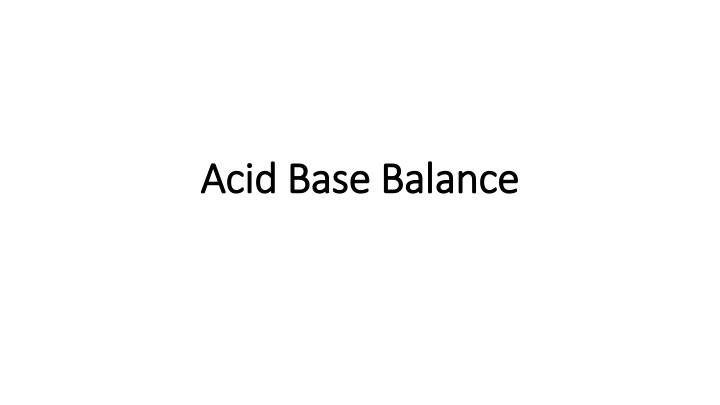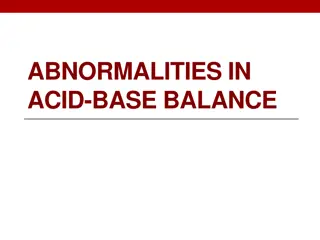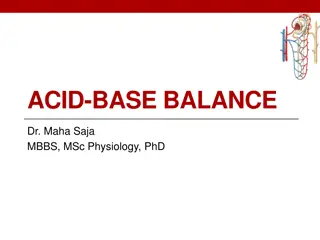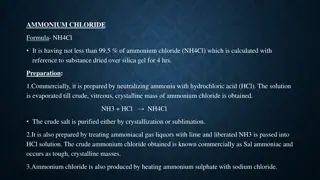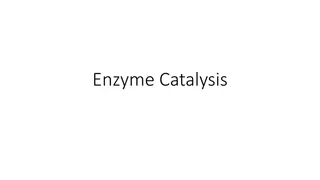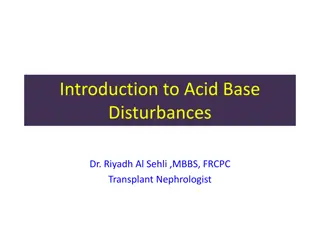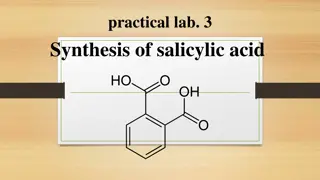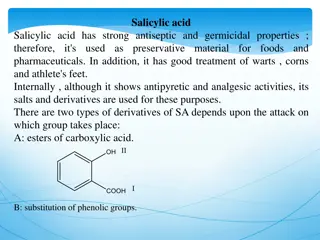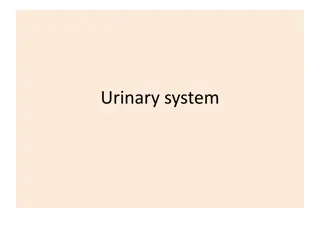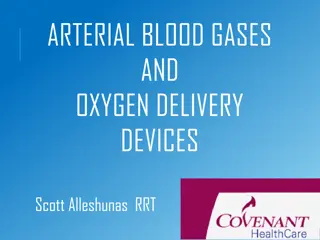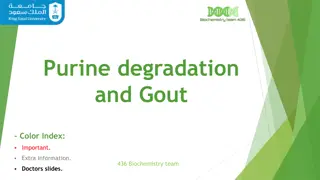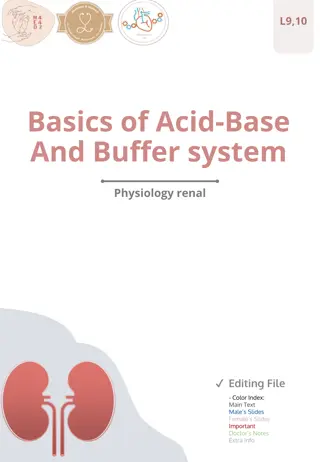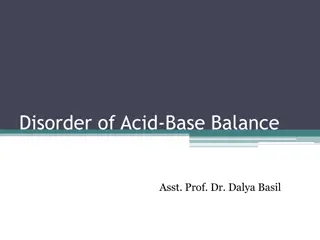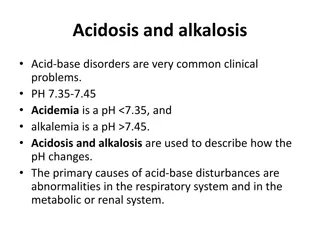Acid Base Balance
Water balance plays a crucial role in human physiology, with varying characteristics from infancy to adulthood. The regulation of body water content and its losses in children reveal key insights into kidney function and overall health. Explore the intricate dynamics of water intake, output, and balance across different life stages, shedding light on the importance of maintaining proper hydration levels.
Download Presentation

Please find below an Image/Link to download the presentation.
The content on the website is provided AS IS for your information and personal use only. It may not be sold, licensed, or shared on other websites without obtaining consent from the author.If you encounter any issues during the download, it is possible that the publisher has removed the file from their server.
You are allowed to download the files provided on this website for personal or commercial use, subject to the condition that they are used lawfully. All files are the property of their respective owners.
The content on the website is provided AS IS for your information and personal use only. It may not be sold, licensed, or shared on other websites without obtaining consent from the author.
E N D
Presentation Transcript
Acid Base Balance Acid Base Balance
WATER INTAKE AND OUTPUT Intake Output Liquids 1600 Urine 1500 Food 700 Sweat (and insensible water loss) 500 Metabolic water 200 Exhaled air (water vapor) 300 Feces 200
Characteristics of water physiology Characteristics of water physiology from infancy to adolescence from infancy to adolescence
Body water content Water is the major component of human body. It represents 60% of an adult s body weight. Due to difference in body composition, children have higher body water content relative to body mass than adults. Water represents 75% of the body mass in infants in first 6 months of life . Then it rapidly between 6 months & 2 years and at a slower rate during childhood. It reaches an adult level by the age of puberty (>12 years). It is also after 12 years old that gender differences appear: water as a % of total body weight at a faster rate in girls, due to the fact that, women have a higher % of body fat than men
Main water losses in children Under normal conditions, body water is mostly lost through urine and skin, & to a lesser extent, from lungs and faeces. Urinary water losses In children, average urinary volume 600 - 1300 mL/d & with age to progressively reach adult values. Skin and lung water losses Body surface area to body mass ratio is different between children & adults. It is twice as high in young children (1-2 years old) as in adults. The difference levels out by adolescence, when children have almost reached their adult size. This explains why until adolescence, children lose more water relative to body mass from the skin at rest and under thermoneutral conditions compared to adults.
Body water balance regulation Body water balance regulation A- Regulation by kidneys Kidneys are able to reabsorb or eliminate water depending on body needs. To achieve this function, they are influenced by several hormones, antidiuretic hormone (ADH), aldosterone and natriuretic factors (peptide). In children, renal function reaches maturity at about 2 years old, with comparable glomerular filtration rate & urine concentrating & diluting capacity to adults. However, voiding volume and frequency are only fully mature by adolescence
B- Thirst mechanism When water losses exceed water intake, the body enters a state of hypohydration. Besides the kidneys, thirst also plays a role in restoring water balance by stimulating the desire to drink. Thirst is a sensation influenced by both physiological (cellular tonicity, extracellular volume, stomach distension, ADH blood volume...) and behavioral factors (meals, preferences, availability of beverage...). However, as for adults, thirst and voluntary drinking do not always guarantee adequate hydration. Indeed, some trials have reported that, when dehydrated and left to their own choice, children and adolescents do not drink enough to ensure the complete replacement of water loss.
C- Thermoregulation Water plays an essential role in the body s process of temperature control. Evaporation of sweat from skin is an effective cooling system & represents the main route of heat loss in adult. In contrast to adults, children lose more heat from convection (dry heat loss) than evaporation. This can be explained by two major physiological differences. I. Children have a larger body surface area to body mass ratio and dry heat exchange depends on surface area. II. Immature sweating mechanisms.Until puberty, children have lower sweating rates than adults, especially boys compared to men. Despite these differences, equivalent thermoregulation outcomes in children and adults exercising in the heat have been observed when adequately hydrated. However, limited data suggest that body temperature rises more quickly in children than in adults. Thus, pre-pubertal children lose less water than adults during exercise and/or in the heat but their body temperature regulation may be more sensitive to dehydration than adults.
To date, there is no significant evidence that children would be at different risk of dehydration or hyperthermia than adults during physical activity under heat In adequately hydrated children, no increased risk of exertional heat-illness has been observed compared to adults (
ELECTROLYTES ELECTROLYTES They are chemicals that dissolve in water & dissociate into ions. Cations are positive ions such as Na+ & K+. Anions are negative ions such as Cl_ & HCO3 _. By creating osmotic pressure, electrolytes regulate osmosis of water between compartments. INTAKE, OUTPUT, AND REGULATION Intake electrolytes are part of food & beverages. Output urine, sweat, feces. Regulation; through; Aldosterone Na+ & K+; ANP Na+; PTH & calcitonin Ca+2 & HPO4-2.
ACID ACID BASE BALANCE BASE BALANCE Normal pH Ranges; blood: 7.35 - 7.45; tissue fluid: similar to blood. ICF: 6.8 - 7.0; Normal pH of body fluids is maintained by; Buffer systems (Bicarbonate , phosphate, & protein) respond within fraction of second. Respiration. Respond within 1- 3 min. Kidneys respond within several hours days.
BUFFER SYSTEMS BUFFER SYSTEMS Each consists of a weak acid & a weak base; react with strong acids or bases to change them to substances that do not greatly affect pH. React within a fraction of a second, but have the least capacity to prevent pH changes, because a limited number of molecules of these buffers are present in body fluids. Its types: Bicarbonate buffer system Phosphate buffer system. Protein buffer system
Bicarbonate Buffer System Bicarbonate Buffer System Important in both blood & tissue fluid; base to acid ratio is 20 to 1. The two components of this buffer system are Carbonic acid (H2CO3), a weak acid. Sodium bicarbonate (NaHCO3), a weak base. If a potential pH change is created by a strong acid, the following reaction takes place: HCl + NaHCO3 NaCl + H2CO3 (strong acid) (weak acid) If a potential pH change is created by a strong base, the following reaction takes place: NaOH + H2CO3 H2O + NaHCO3 (strong base) (weak base)
RESPIRATORY MECHANISMS RESPIRATORY MECHANISMS It affects pH because it regulates amount of CO2 present in body fluids. Resp. system may be the cause or may correct pH imbalance (from other causes).
Respiratory acidosis Causes; rate or efficiency of respiration(eg asthma, & pneumonia) excess CO2 excess H+ ions formation lower pH of body fluids: CO2 + H2O H2CO3 H++ HCO3. Compensation; Kidneys excrete H+ ions & reabsorb Na+ ions & HCO3- ions. Respiratory alkalosis (less common) Causes rate of respiration (eg; anxiety, high altitude) amount of CO2 exhaled. Because there are fewer CO2 molecules in body fluids fewer H+ ions are formed, & pH tends to rise. Compensation; Kidneys retain H+ ions & excrete Na+ ions & HCO3- ions
Respiratory Compensation for Metabolic pH Changes Respiratory Compensation for Metabolic pH Changes Metabolic acidosis or alkalosis are changes in pH caused by other than a respiratory disorders. Respiratory mechanism does not have the capacity to fully compensate an ongoing metabolic pH imbalance (In such cases, respiratory compensation is 50 - 75% effective).
Metabolic acidosis Causes; e.g kidney disease, uncontrolled DM, excessive diarrhea or vomiting. Compensation; excess H+ ions in body fluids stimulates respiratory centers in medulla rate of respiration to exhale more CO2 H+ ion formation. Metabolic alkalosis is not common, Causes; eg overuse of antacid medications or vomiting of stomach contents only. Compensation; As pH begins to rise breathing slows & amount of CO2 exhaled (CO2 retained within body) H+ ions formation.
RENAL MECHANISMS RENAL MECHANISMS Kidneys regulate pH of ECF by excreting or conserving H+ ions & by reabsorbing Na+ ions & HCO3- ions. Although renal mechanisms have the greatest capacity to buffer E.g ketoacidosis in untreated diabetes mellitus ( metabolic acidosis). As ketones (acid) accumulate in blood, capacity of ECF buffer systems is quickly exhausted. Breathing rate then , & more CO2 is exhaled to H+ ion formation. There is a limit to how much respiratory rate can , Renal buffering mechanisms will then become effective.
EFFECTS OF pH CHANGES EFFECTS OF pH CHANGES Acidosis is most detrimental to CNS, causing impulse transmission at synapses. A person in acidosis becomes confused & disoriented, then lapses into a coma. Alkalosis affects both CNS & PNS. synaptic transmission, even without stimuli. It is first indicated by irritability & muscle twitches & Progress to muscle spasms & convulsions.
FUNCTIONS OF THE KIDNEYS FUNCTIONS OF THE KIDNEYS
Excretion of metabolic waste products, foreign chemicals, drugs, & Hs. Regulation of Arterial blood Pressure; kidneys contribute in: long-term regulation by excreting variable amounts of Na+ &water. short-term regulation by secreting vasoactive substances, such as renin. Rennin angiotensin mechanism: Sequence; BP stimulates juxtaglomerular cells in kidneys to secrete renin. Renin splits plasma protein angiotensinogen(synthesized by liver)to angiotensin I. Angiotensin I is converted to angiotensin II by an enzyme found in lung & vascular endothelium. Angiotensin II vasoconstriction & stimulates adrenal cortex to secrete aldosterone. Secretion of erythropoietin H is secreted whenever blood O2 level (hypoxia). It stimulates red bone marrow to the rate of RBC production. Synthetic erythropoietin is available for hemodialysis patients, cancer patients & AIDS patients with severe anemia. Activation of vitamin D This vit. exists in several forms that are converted to calcitriol (D2) by kidney. D2 is active form of vit.D that intestinal absorption of Ca+2& phosphate. Regulation of acid base balance. Gluconeogenesis ; kidney synthesize glucose from a.a during prolong fasting.
Kidney Nephron Kidney Nephron It is structural & functional unit of kidney where urine is formed. Each kidney contains 1 million nephrons. Each nephron has two major portions: a renal corpuscle & a renal tubule.
Juxtaglomerular complex Juxtaglomerular complex consists of; 1) Macula densa cells: Specialized epithelial cells in initial portion of DCT that comes in close contact with afferent & efferent arterioles. Contain Golgi apparatus. 2)Juxtaglomerular cells in walls of afferent & efferent arterioles adjacent to macula densa.
FORMATION OF URINE FORMATION OF URINE Although about 45 gallons of filtrate is produced daily, most of water is reabsorbed (importance ?). Conservation of water is largely due to long loop of nephron, which establishes a concentration gradient in kidney tissue. Water can leave collecting duct by osmosis & return to bloodstream in the surrounding peritubular capillaries.
URINATION REFLEX (micturition URINATION REFLEX (micturition or voiding This reflex is a spinal cord reflex over which voluntary control may be exerted. Stimulus for reflex is stretching of detrusor muscle of bladder. Bladder can hold 800 mL of urine, but reflex is activated long before maximum is reached. When urine volume reaches 200 - 400 mL, stretching generate sensory impulses to sacral spinal cord Motor impulses return along parasymp. nerves to detrusor m. contraction. At the same time, internal urethral sphincter relaxes. If external urethral sphincter is voluntarily relaxed, urine flows into urethra, & bladder is emptied. If bladder continues to fill & be stretched, voluntary control is no longer possible. voiding).
